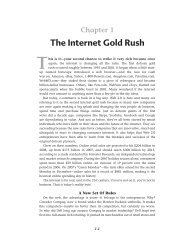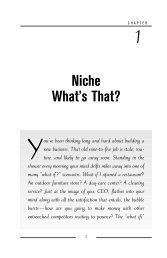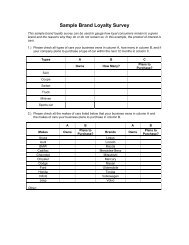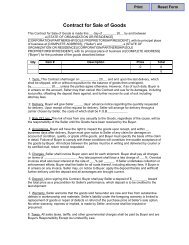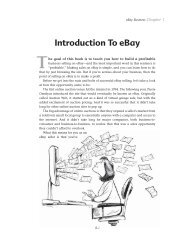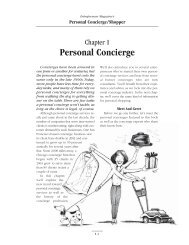Chapter 1 Mail Order Mania
Chapter 1 Mail Order Mania
Chapter 1 Mail Order Mania
You also want an ePaper? Increase the reach of your titles
YUMPU automatically turns print PDFs into web optimized ePapers that Google loves.
<strong>Chapter</strong> 1<br />
<strong>Mail</strong> <strong>Order</strong> <strong>Mania</strong><br />
<strong>Mail</strong> order is not new—in fact, it can be traced back more than a century. But it’s in<br />
demand, by consumers and entrepreneurs alike. Why? Reasons abound, both personal<br />
and commercial.<br />
This chapter explores the flourishing business of mail order—a sort of in-your lap TV<br />
news magazine report without the commercials. We’ll delve into the steadily rising<br />
economic success of the field and dip into the secrets of America’s mail order industry.<br />
WISH FULFILLMENT<br />
Everybody loves to get something in the mail—except, of course, those pesky bills. A<br />
letter—or especially a package—delivered to your door is like a birthday gift any time of<br />
the year. It’s wish fulfillment. Even if the contents are something as mundane as kitchen<br />
towels or a car mat, that package makes you feel like you’ve received something special<br />
and exciting. So it’s no wonder that mail order is in demand.<br />
The venerable Sears Roebuck catalog, a pioneer mail order piece, was dubbed “The Wish<br />
Book” because it gave people the power to choose whatever they wanted and have that<br />
wish granted simply by sending off an order form and a payment. Sears, however, was<br />
not the first mail order company.<br />
MAIL ORDER’S DAD<br />
The title of “Father of <strong>Mail</strong> <strong>Order</strong>” goes to Aaron Montgomery Ward, a savvy traveling<br />
salesman who, in 1872, decided that direct mail was a terrific way to get quality<br />
merchandise to rural Americans who frequently suffered at the mercy of substandard<br />
goods. The 28-year-old entrepreneur founded his company—and America’s shop-by-mail<br />
industry—with a single sheet of paper listing 163 products, the cornerstone of what<br />
would become the Montgomery Ward catalog. Sears, Roebuck and Co., founded by<br />
railway station agent Richard W. Sears and watchmaker Alvah C. Roebuck, came into<br />
being about 20 years later. By 1895, the Sears catalog weighed in at a hefty 532 pages,<br />
crammed with everything a shopper could want, from shoes and buggies to fishing tackle<br />
and furniture. A few years later, you could even buy a house from the Sears catalog.<br />
Today, mail order is still an exciting, high-demand source of merchandise. The Direct<br />
Marketing Association (also known as the DMA) estimates that each year more than 200<br />
million Americans order a product or service by phone, mail, or the internet.<br />
Why are we including phone sales in our mail order figures? Because mail order is<br />
actually an inaccurate moniker for direct marketing, which includes any form of shop-athome-or-office<br />
order placement, from mail to phone to e-mail. Because most people use<br />
the term “mail order” to cover these broad bases, we’ll continue to do so within these<br />
pages.
What makes mail order so hot today? One reason remains the same as when Aaron Ward<br />
had his brainstorm—the convenience of shopping from home. Ward, however, based his<br />
marketing strategy on the fact that his customers were rural and did not have access to the<br />
higher-quality goods available in urban areas. Today, there is a wider range of reasons<br />
why people in all areas, including major cities, find that shopping at home is an easy<br />
means of buying items.<br />
OFF-DUTY SHOPPING<br />
In today’s marketplace, most customers can easily access any number of retail stores but<br />
don’t necessarily have the time. More and more Americans are part of a two-income<br />
household, stretched between work and child rearing, with scant time for leisure—much<br />
less shopping. Single parents, stretched even further to be in several places at once, have<br />
reached the conclusion that ordering from home can simply be easier than dragging the<br />
kids to the mall.<br />
So mail order fulfills wishes, as well as meets people’s needs. It grants consumers the<br />
ability to shop in the privacy of their own homes, saving on gas and time spent looking<br />
for parking. It also lets you shop at midnight if you choose. Yes, you can leisurely browse<br />
through the pages of mail order catalogs that offer just about everything you can<br />
imagine—with your feet up, a cup of coffee at hand, with the TV on if you choose, while<br />
listening to a CD, or in peace and quiet. Perhaps you prefer cruising the pages of an<br />
online catalog on your laptop. However, you choose to browse, you can still do it in the<br />
comfort of your own home.<br />
If you have questions, you pick up the phone, key in a number (usually tollfree), and talk<br />
to a knowledgeable customer assistant. No more frustration trying to track down elusive<br />
store clerks who often don’t have the answers anyway. When you’re ready to buy, you<br />
order by phone, mail, internet, or e-mail in minutes. No more standing in line! No wonder<br />
mail order is the modern shopper’s paradise!<br />
THE FLIP SIDE<br />
What’s the flip side to mail order’s advantages? Although we’d be lying if we said there<br />
wasn’t one, mail order’s negative points are few. One is that consumers can’t handle the<br />
merchandise until after they’ve paid for it. As a buyer, you have to rely on photos and<br />
text to give you the full flavor of the goods. You can never be entirely sure of the size,<br />
color, or quality until it shows up at your home. Of course, if you don’t like what you get,<br />
you can almost always return it, but this takes a certain amount of effort and eliminates<br />
most of the fun, especially if you need (or want) the product right away. The socialization<br />
of shopping is also lost through mail order, since you’re not as likely to get three friends<br />
together to browse a catalog as you are to walk through the mall. In fact, many people<br />
still enjoy shopping excursions, then come home and order via the internet. Why?<br />
Sometimes they find a better price, and other times they just didn’t feel like carrying<br />
heavy merchandise home.<br />
Another mail order minus is the time element, since you have to wait until the item shows<br />
up, whereas if you ran out to the mall, you could have the merchandise in your home the
same day. Most mail order companies will ship your goodies overnight by FedEx if<br />
you’re willing to pay extra for the service, but if you’re not, you face a certain lag time.<br />
And if those goodies happen to be the wrong fit or the wrong color, there’s an even<br />
greater delay while you send them back and wait—again—for the replacements to arrive<br />
or to receive a credit or refund.<br />
The last mail order negative is a sort of stigma bearing the word “scam.” Although many<br />
mail order companies, from L.L. Bean to Lands’ End to Lillian Vernon, have sterling<br />
reputations, the idea persists in some minds that mail order is a hotbed of phony<br />
merchandise hawkers. Because there were (and still are) some wolves devouring<br />
customer lambs, the FTC created the <strong>Mail</strong> <strong>Order</strong> Merchandise Rule (now called the <strong>Mail</strong><br />
or Telephone <strong>Order</strong> Merchandise Rule) in 1975 to regulate direct-marketing businesses.<br />
Let’s just say that Big Brother is watching out for mail order customers and that the<br />
majority of mail order businesses are legit.<br />
BRAIN CELL APPLICATION<br />
So far, we’ve examined mail order from the consumer’s perspective. Now let’s take a<br />
look at the industry from the businessperson’s point of view. What do we see? An<br />
industry that is potentially lucrative for the savvy, hardworking entrepreneur and that has<br />
the advantage of requiring relatively little in the way of startup expenses, specialized<br />
skills, or intensive apprenticeship—as opposed to, say, professions like medicine, law,<br />
high rise construction, or restaurant management. Bear in mind, however, that this does<br />
not mean you can make a fortune without lifting a finger or applying a brain cell. To be<br />
successful in mail order, you’ll need a generous measure of hard work, a concerted and<br />
constant study of the industry as a whole as well as your particular niche, and the ability<br />
to roll with the punches. You’ll also need to be prepared to have a lot of fun!<br />
So let’s take a look at the reasons entrepreneurs love mail order. One is that it is as<br />
convenient for the direct marketer as it is for the consumer. Since your customers’ visits<br />
are all virtual, you can work from home—basing your operations in a spare bedroom, at<br />
the kitchen table, or even in a corner of the garage, if necessary, until your efforts bear<br />
enough fruit to furnish a “real” office. Many of the most successful catalogs, such as<br />
Lillian Vernon, began at a kitchen table, in a spare bedroom, or in someone’s garage.<br />
MAIL ORDER MOONLIGHTING<br />
<strong>Mail</strong> order offers the option of starting as a part-time business, which allows you to get<br />
your feet wet without jumping into the pool. In fact, many direct marketers insist that<br />
moonlighting is the wisest way to go. John Schulte, chair of the National <strong>Mail</strong> <strong>Order</strong><br />
Association (NMOA), believes traditional and internet-based mail order are the last<br />
frontiers for the little guy. “You can find ways to make things happen part time from your<br />
kitchen table,” says Schulte.<br />
Competition in the mail order biz is tough. But if you start out part time, you can allow<br />
yourself on-the-job training without on-the-job financial anxieties. And if you don’t want<br />
to sever the ties with your full-time employer until you know you can make it on your<br />
own, mail order is an ideal business for you.
What else makes mail order shine for the startup entrepreneur? You don’t need a lot of<br />
inventory. You can sell merchandise through a drop-ship arrangement. No, we aren’t<br />
suggesting that you parachute goods to customers like in the Berlin Airlift. Drop shipping<br />
is an arrangement in which a third party, such as a manufacturer or wholesaler, sells you<br />
the merchandise while keeping it in their warehouse until you make the sale. Then it is<br />
shipped from them to your customer. Or you can start out with one product or service,<br />
rather than go the L.L. Bean 16,000-products route, and keep your inventory manageable<br />
as you grow.<br />
Keep in mind that mail order lends itself to services as well as merchandise. You can<br />
offer everything from antique appraisal to desktop publishing to genealogical research—<br />
and for most services, your inventory list will be minimal.<br />
Yet another mail order plus: You don’t need to ship the product until your customer’s<br />
check or credit card clears the bank. Unlike your store-bound retail colleagues, you’ve<br />
got no bounced-check worries.<br />
THE TOP CONTENDER<br />
What are mail order’s minuses from the business owner’s viewpoint? Again, there are<br />
few, with the top contender being the tough competition from all the other direct<br />
marketers out there. As a mail order maven, you’ll have to be clever, creative, and<br />
persistent—and this book will help.<br />
Another major minus from the direct marketer’s side of the fence is the old “scam”<br />
stigma we mentioned earlier. Customers who wouldn’t hesitate to hand over their money<br />
in a retail store can balk at sending it through the mail or giving their credit card<br />
information over the phone or the internet. With the increase in identity theft, customers<br />
are leery of shopping at places that are unfamiliar. For this reason, you need to work<br />
overtime to establish a reputation as trustworthy and have an infrastructure in place that<br />
cannot be tampered with by scammers, spammers, or web-savvy thieves. Encryption<br />
technology and privacy pages explaining that you are protecting your customers rights<br />
are extremely important today.<br />
COUNTING YOUR COCONUTS<br />
What can you expect to make as a mail order entrepreneur? The amount is entirely up to<br />
you, depending only on how serious you are and how willing you are to work for the<br />
rewards. One of the entrepreneurs we interviewed for this book brings in annual gross<br />
revenues of $150,000; another brings in more than $1 million. Schulte of the NMOA says<br />
annual incomes for the industry range from $40,000 to more than $100,000, depending<br />
on how long the business has been in operation and how much has been invested in<br />
building the business.<br />
By a mail order company’s fourth or fifth birthday, Schulte says, about 60 percent will<br />
find themselves in the $0 to $40,000 bracket, about 25 percent will fall into the $40,000<br />
to $100,000 category, and a final 15 percent will land in the $100,000-plus range. Schulte<br />
estimates that it takes two to four years to break even with a mail order operation.
“Profitability,” he advises, “comes at about the same time, in three to five years. You<br />
want to start breaking even right away, but the real profits come when you have a solid<br />
customer base that buys from you with some frequency. It takes a few years to build up<br />
this base.”<br />
And while success doesn’t come overnight to most, it doesn’t come at all to some. “Only<br />
about 20 percent make it,” cautions Schulte. This isn’t a reason to quit before you start,<br />
but it’s a darn good reason to do your research, plan very carefully, and get everything in<br />
place before you start. That’s why you bought this book!<br />
CRANK-UP COSTS<br />
One of the Catch-22s of being in business for yourself is that you need money to make<br />
money—in other words, you need startup funds. With mail order, you can start off with a<br />
much more manageable investment than your peers in retail or manufacturing. Since you<br />
can start as a one-person show in your own home, you automatically eliminate expenses<br />
like rent and employees. As an added bonus, equipment costs are relatively low; your<br />
major outlays will be for a computer, software, two to three phone lines, a digital camera,<br />
internet access, and a website. This whittles your other initial expenses down to<br />
inventory, advertising (which can be considerable—but necessary), and possibly some<br />
other technical accessories. But don’t get too carried away with the idea of starting on the<br />
proverbial shoestring. There’s a downside, which is that starting small can limit your<br />
company’s potential growth. You need to start with enough funding to give yourself a<br />
legitimate chance to succeed. Undercapitalization is a major reason mail order<br />
entrepreneurs fail.<br />
You can start with a limited investment, but you’ll have to be especially creative, and<br />
you’ll have to really focus your energies on what many experts see as the lifeblood of the<br />
successful mail order business: the repeat customer.<br />
For now, let’s say you can expect your startup costs to range from about $5,000 to<br />
somewhere over the $250,000 mark, depending on what sort of operation you choose to<br />
start. If you plan to start small, with a brochure-sized catalog or a print ad, your startup<br />
figure will be relatively low. If you decide to start out with a 48-page catalog to rival<br />
those of Lands’ End and J. Crew and mail it to 100,000 people, you’re looking at a lot<br />
more money.<br />
To conserve your capital, you can always do a catalog from your kitchen table, design it<br />
yourself on a computer, and go with a much smaller mailing. You’re not going to go from<br />
nothing to Lands’ End, with its annual nine-figure revenues, overnight—but remember, it<br />
takes time. A successful catalog isn’t built in a day.<br />
In this book, we’re going to show you how to do things from a variety of perspectives,<br />
but the emphasis will be on doing them as reasonably as possible so that you can keep<br />
your costs to a minimum. Then, as we’ve said, the rest will be up to you!<br />
ROCK OF GIBRALTAR
Besides startup costs and profits, two other important factors to consider are risk and<br />
stability. You want a business that, like the Rock of Gibraltar, is here to stay. <strong>Mail</strong> order<br />
definitely qualifies as a “keeper” business, but choosing a business with a proven track<br />
record isn’t the key to overnight success.<br />
Even with its relatively long history, mail order’s stability rates a “moderate” on the<br />
business startup scale. Once you get to the point where you’ve got a good customer<br />
base—which can take a few years—your company should be on a firm foundation.<br />
While everyone’s heard tales of somebody who made it rich in mail order overnight, that<br />
somebody was either the exception to the rule or an urban legend like the stories of<br />
alligators in the New York sewer system—entertaining to hear about, but not necessarily<br />
true. As we mentioned earlier, industry experts agree that most direct-marketing<br />
businesses don’t become profitable until three to five years after the initial investment.<br />
<strong>Mail</strong> order can be lucrative, and you can have a heck of a lot of fun getting there, but you<br />
have to be willing to put in lots of time, effort, and startup capital—and you have to be<br />
willing to take risks.<br />
The risk factor in starting a mail order business is also considered moderate—less than<br />
opening a tofu taco restaurant but more than selling 10-cent cups of coffee to caffeinedeprived<br />
commuters. The reason, as we’ve said, is that the competition is fierce. Unless<br />
you’ve got the right combination of factors—an understanding of your potential<br />
customers’ wants and needs matched with topnotch marketing skills—you’ll have a hard<br />
time making it. Not to worry, though. There’s a method to the magic of finding that<br />
perfect combination, and we’ll show it to you in <strong>Chapter</strong> 3.<br />
THE RIGHT STUFF<br />
OK, you’ve decided that running a mail order business is potentially profitable. You’re<br />
willing to invest not only the money but the time to learn the ropes and become<br />
established as a pro. What else should you consider? Your personality.<br />
Not everyone is cut out to be a mail order maven. This is not, for example, a career for<br />
the creativity-challenged. If you’re one of those folks who’d rather undergo a root canal<br />
than come up with peppy advertising copy, then you don’t want to be in mail order. It’s<br />
also not a career for the math-phobic. Believe it or not, there’s a lot of number crunching<br />
involved in the mail order business. It’s fun because it tells you how well your creative<br />
ideas are doing, but if you’re a person who draws the line at working with figures, then<br />
you don’t want to be in mail order, either.<br />
This is also not a career for the time-management deficient. If you’re a star procrastinator<br />
who can’t seem to send anything out in the mail until it’s already overdue, then you<br />
should definitely look elsewhere for entrepreneurial satisfaction. If, on the other hand,<br />
you delight in dreaming up advertising ideas, you enjoy calculating how well your plans<br />
are paying off, and you’re an efficient time manager, then a mail order company is<br />
probably a good business for you to start.
MIX IT UP<br />
This doesn’t mean that only ad agency executives or accountants need apply. <strong>Mail</strong> order<br />
entrepreneurs come from all avenues of life. The ones we interviewed for this book<br />
represented a variety of careers: food writer and cooking teacher, mom, computer<br />
information specialist, bookkeeper, and romance writer.<br />
The tip here is that all of these entrepreneurs figured out how to make their backgrounds<br />
and interests work for them in their new careers. They’ve taken the skills and enthusiasm<br />
they’ve already acquired and applied them to the mail order business—which is crucial to<br />
being a successful direct marketer. Many top mail order experts have long agreed that<br />
you can most effectively sell something with which you are familiar. While a minority of<br />
sales people can sell “anything,” most successful mail order marketers have an interest,<br />
even a passion for what they sell. Such familiarity helps not only in selecting<br />
merchandise and in dealing with customers, but in following trends in the life of a<br />
product—and most products change in styles (and/or technology) often to keep up with<br />
the times.<br />
“It’s very good for people who have a special knowledge, skill, or interest that they want<br />
to share,” John Schulte of the NMOA advises, “and who can find a way to contact others<br />
who share the same passion.” That’s exactly what the entrepreneurs we interviewed have<br />
done.<br />
Beth Hillson, a food writer and cooking teacher, got into mail order through her<br />
knowledge of foods for people on a gluten-free diet. “I started in January of ’93,” the<br />
Connecticut resident recalls. “My son and I are both allergic to glutens, so I started<br />
making mixes that I could use for myself. Then I converted them into formulas that I<br />
could mix up in large batches and started offering them to people in various support<br />
groups around the country. By July, I was so overwhelmed with requests that I couldn’t<br />
keep up. I had to go to somebody to help me make them. It’s really grown from there.”<br />
Hillson’s business, The Gluten-Free Pantry, has definitely grown. From five products and<br />
a small flier sent to support groups, she has expanded to a line of products that fills a 28page<br />
catalog and has mail order sales from around the world.<br />
HEY, SPORTS FANS<br />
Kate Wolford, whose mail order company, Just for Fans, caters to a very different<br />
market, also notes that it takes some time to learn and to grow your business. “I think that<br />
in your first couple of years, your learning curve is tremendous,” the Overland Park,<br />
Kansas, resident says. Wolford began her business two and a half years ago and bases her<br />
product line on her alma mater’s football team.<br />
“My husband is a huge, huge fan, and he wears [the team’s logo on] everything,” the<br />
Midwestern entrepreneur explains. “He wears the watch, shirts galore, everything. We’re<br />
both graduates of the university, so we’re big fans.”
As Wolford discovered, she and her husband weren’t the only “expatriate” fans.<br />
Graduates from their university had moved all around the country, and they all were<br />
eager for team logo products. Wolford decided she’d like to start selling team<br />
merchandise, but her husband nixed the idea of a retail store because of the costs<br />
involved. The former bookkeeper wasn’t deterred. She kept thinking about the concept<br />
and arrived at a goal: to engage people like herself and her husband, alumni who had<br />
moved away from the city where the university is located but still had plenty of team<br />
spirit.<br />
Finally, Wolford hit on mail order as the perfect vehicle to reach this large market. “We<br />
decided on it because we could keep down the costs of everything associated with a retail<br />
outlet, like rent and employees. It could be done on a smaller basis, with just me starting<br />
the business,” Wolford adds. “We could also do nationwide distribution, which was<br />
ultimately what I wanted to do.”<br />
FILLING A NEED<br />
Caryn O’Keefe began her company based on a lifelong knowledge of her products and,<br />
like Wolford, as a way to fill the needs of people she knew were potential customers. “I<br />
didn’t have a background in mail order, but I’ve always been around people in the fabric<br />
business,” she says. “My grandparents and great-grandparents had all been in the garment<br />
and fabric industry. So I was familiar with textiles—the industry, the people in it, and<br />
which companies were reputable.”<br />
She also knew what people needed within the industry. “I saw a need [among] small<br />
manufacturers who are constantly struggling to stay in business and constantly going out<br />
of business because they’re forced to buy more than they need to get good pricing, ”the<br />
Roswell, Georgia, entrepreneur explains. “I saw a need for people who do crafts to be<br />
able to make extra money for their families. They needed to be able to get fabric at a<br />
good price. I also saw a [way to help] home sewers who might have children in the home<br />
and find it difficult to get out when they need something or find their selections limited to<br />
their local stores.<br />
“So, for all those reasons, I tried to create a business that could help these different<br />
people fill their needs and help other businesses stay in business and make money.”<br />
O’Keefe has gone on to fulfill her vision. Today, her company, The Fabric Club, employs<br />
10 people, and has customers all over the world.<br />
USING HER EXPERTISE<br />
After more than 20 years in the party planning business, which included writing 10 books<br />
on the topic and traveling around speaking on how to plan all sorts of parties, Patty<br />
Sachs, from Minneapolis, Minnesota, wanted to spend less time in airline terminals and<br />
more time at home.<br />
“I had been hired by Polaroid to introduce a new camera. They wanted me to help them<br />
promote it as a life-of-the-party type of thing, showing people how they could have fun
with photos. It was great, I did that promotion and worked for them for a couple of<br />
years,” explains Sachs. Along the way, she would demonstrate how you could take little<br />
white folders and put your photos inside to create souvenir framed photos from parties.<br />
Pretty soon, she found a lot of inquiries about the folders, which she bought as a local art<br />
supply shop.<br />
“I asked a PR firm that I had worked with and they didn’t know where to get them.<br />
Neither did the folks at Polaroid, so I went online and tried tracking down a vendor, and<br />
it wasn’t easy to find.”<br />
When Sachs finally found a vendor, it set off the proverbial light bulb: The idea was to<br />
turn this into an online mail order business selling the folders (photo frames). Wellversed<br />
in the party planning business, Sachs expanded on her initial idea. “It was five<br />
years ago that I started with a fairly basic website. The next thing I know I’m selling<br />
Halloween Pumpkin folders, Santa Claus folders; the kind where you take pictures of the<br />
kids with a character at malls or at churches or schools,” adds Sachs, who now has some<br />
100 designs of Polaroid folder frames that can be used as souvenirs, plus a variety<br />
designed for digital camera photos as well. In addition, she sells party goods on her now<br />
revamped and improved website, InstantPhotoFrames.com.<br />
MAIL ORDER PASSION<br />
While “doing your own thing” is a definite plus in the mail order business, it’s not the<br />
only thing to consider. The most important factor in mail order success, the one stressed<br />
again and again by entrepreneurs and industry experts alike, is passion—for the mail<br />
order industry as a whole and for your product line in particular. After all, you’re going to<br />
be working with this merchandise for a long time, so make sure it’s something you love<br />
and believe in. It’s very difficult to sell a product that you wouldn’t want to buy or own,<br />
so you need to know about what you’re selling and be passionate about it as well.<br />
STATE OF THE INDUSTRY<br />
If you’re still reading, we assume you’ve decided to take the plunge and forge ahead with<br />
your new career. There is, however, one more thing to take into consideration: the<br />
industry prognosis. Fortunately, the prognosis is good. As we saw at the start of the<br />
chapter, there’s a great big, beautiful tomorrow for the direct-marketing industry.<br />
It’s always possible, of course, that economic disaster will befall the country, making it<br />
difficult for customers to afford retail merchandise of any kind. But history so far has<br />
shown mail order to be an industry that has not only survived, but thrived, through every<br />
downturn and depression over the past century.<br />
“The latest thing in mail order is, of course, using the internet as a way of showing off<br />
your goods,” explains John Schulte of the NMOA, referring to electronic catalogs and<br />
websites selling a vast range of goods and services. “They give it different names, but it’s<br />
really all mail order. It’s just a new medium for delivering your message and submitting
orders,” says Shulte, recalling that when the 800 phone number became available, mail<br />
order didn’t turn into the 1-800 business, it was just a new way to take orders. “It’s still<br />
remote or distance selling,” adds Schulte.<br />
According to Schulte, one of the big positives of the internet is that it can help<br />
newcomers to the industry by keeping the costs down. The cost of entering the business<br />
and maintaining a mail order company with a catalog was becoming increasingly difficult<br />
prior to the internet because of the slowly but steadily, rising costs of paper, printing, and<br />
postage.<br />
“Then along came the internet. In the beginning, it was also expensive to get into because<br />
you needed an HTML programmer, and they were few and far between. There was no<br />
such thing as a shopping cart [program], so everything you wanted to do was expensive<br />
and time-consuming. But now the price has gone way down and if you have some<br />
patience and a couple of hours to educate yourself, you can build an effective website<br />
using templates,” says Schulte, noting that web servers cost about $19.95 per month or<br />
less.<br />
Of course, it’s not all about the internet. Catalogs today drive sales and, in fact, people<br />
will browse catalogs at their leisure and then often place orders online. Companies can<br />
offer some of their top-of-the-line products in catalogs and more on the internet, saving<br />
money by creating a smaller, more affordable catalog. Another plus for the industry is the<br />
great diversification and specialization of the media today. <strong>Mail</strong> order mavens no longer<br />
have to spend big bucks to advertise in one of a few magazines or on one of a handful of<br />
TV stations, reaching many people who aren’t interested in their products. Instead,<br />
specialization has proved beneficial to small-business owners by allowing them to<br />
advertise in magazines and on TV stations directed at their target audience. For example,<br />
if you’re selling small kitchen appliances by mail order, rather than advertise on one of a<br />
few major TV networks channels, you can zero in on a channel that reaches your specific<br />
audience, such as the popular cooking channel. For less money, the modern entrepreneur<br />
can reach a smaller, but more highly targeted, audience.<br />
The internet, lower startup and maintenance costs, and advertising specialization are just<br />
some of things contributing to mail order’s steady growth rate in the 21st century.



